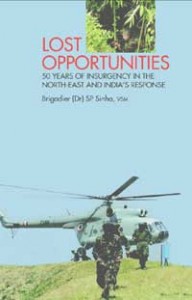The Demand for Nagalim
Naga’s demand for the creation of Greater Nagaland, called Nagalim, which will constitute not only the four hill districts of Manipur, but also parts of Assam, Arunachal and even Myanmar, is the major hurdle in the ongoing peace talks between the Centre and NSCN (IM). Neither Assam nor Manipur will allow any diminution of their present boundaries. The ongoing peace process is already faltering on this issue. The army has been warning that the Naga rebels are using the cease-fire for consolidating their position. In many parts of Nagaland and Manipur, the insurgents run a parallel government and have levied household taxes.
The recent advertisement in the local newspapers for recruitment in the underground government is a clear violation of the cease-fire agreement and reinforces army’s apprehension that NSCN (IM) has taken advantage of the cease-fire to spread its influence. The government will do well to prepare to cope with such a situation, if the talks fail.
Narco-Terrorism
The biggest challenge to the security of the North-east in future will come from narco-terrorism. No insurgent group can sustain itself for long without regular flow of funds. North-east has emerged as a major transit route for narcotics trade and gunrunning. An indicator of the scale of narco-trade is the high incidence of drug abuse, mainly in Manipur, Mizoram and Meghalaya.
Most of the narcotics trade is through Moreh in Manipur; the Naga-Kuki clashes are direct consequence of insurgent groups trying to control the road from Moreh to Imphal to facilitate illegal trade. The demand for funds will fuel illegal trade in narcotics in a big way in future.
Pakistan’s Alternative Proxy War
Pakistan’s proxy war in Kashmir, which started in 1989, has run its course and failed in achieving its objective. But it hasn’t given up hope. According to a recent study by the government, Pakistan has launched a new operation to redouble its destabilising work in India through Bangladesh. Pakistan was developing Bangladesh as the new base for its anti-India operations, and it is reported that it has already shifted almost 200 terrorist training camps from Pakistan Occupied Kashmir to Bangladesh.3
The Chinese Shadow
The Chinese stopped supporting insurgency in the North-east in 1979. But intelligence reports indicate that the Chinese support has not fully dried up. Speaking in the Parliament on December 13, 2000, Minister of State of Home, Mr ID Swamy said that SULFA had disclosed that some of their colleagues crossed over to China from Bhutan and established contact with the Chinese in 1993.4 A confidential IB report to the Home Ministry, the Chinese military have spread their area of operations in all seven states of the North-east and are running a parallel administration with the help of local militants.
Also read: Did the British Really Divide India to rule?
The report also said that 60 to 70 percent of illegal arms are being supplied to the rebels by the Chinese military.5 Furthermore, in the year 2000, Indian intelligence disclosed that NSCN (IM) had revived the Chinese connection, which was believed to have snapped in the 1980s. Reports have also indicated that the NSCN (IM) has a full-fledged liaison office in Chinese territory across the border with Arunachal.6 There are reports of ISI spying and collecting information about troops deployed in the North-east.7 Who benefits from this intelligence? There is a view that China may be using channels established by the ISI for its own use. This cannot be easily discarded and needs to be carefully watched and analysed.
 In India there is once again a new romanticism about China. In the prevailing geo-political scenario, China has inevitably to be an adversary. As long as India is silent about Tibet, it is fine with China. The day India shows any inclination to speak for the Tibetans, the Chinese are poised to destabilise the North-east.
In India there is once again a new romanticism about China. In the prevailing geo-political scenario, China has inevitably to be an adversary. As long as India is silent about Tibet, it is fine with China. The day India shows any inclination to speak for the Tibetans, the Chinese are poised to destabilise the North-east.
Notes and References
- EN Rammohan, “Bangladesh and India’s Security”, paper presented at the USI National Security Seminar 2004 on “India and its Neighbour other than Pakistan” at New Delhi on 9-10 November 2004.
- Bertil Linter, “Bangladesh a Cocoon of Terror”, Far Eastern Review, April 4, 2002.
- Arun Shourie, Will the Iron Fence Save a Tree Hollowed by Termites: Defence Imperatives Beyond the Military, (New Delhi, Asa Publishers, 2005), p. 205.
- The Indian Express, New Delhi, December 14, 2001.
- The Statesman, New Delhi, December 20, 2000, p. 5.
- The Pioneer, New Delhi, February 22, 2001.
- Arun Shourie, n. 3, p. 204.




